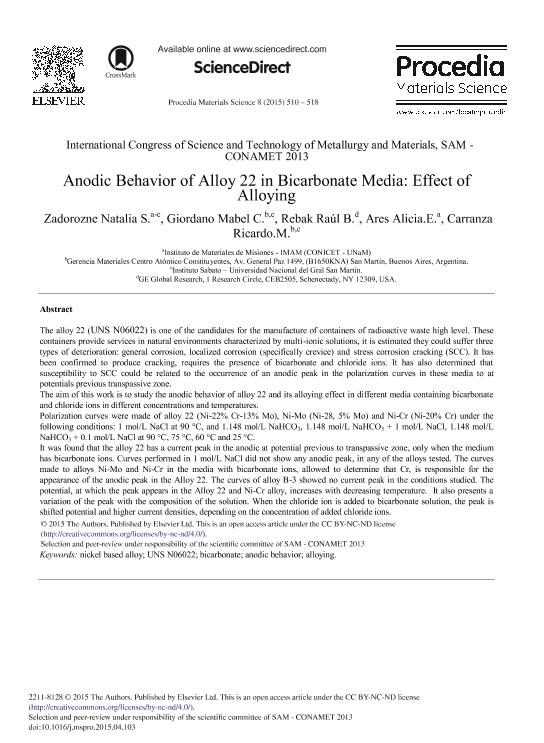Mostrar el registro sencillo del ítem
dc.contributor.author
Zadorozne, Natalia Silvina

dc.contributor.author
Giordano, Mabel Cristina

dc.contributor.author
Rebak, Raúl B.
dc.contributor.author
Ares, Alicia Esther

dc.contributor.author
Carranza, Ricardo M.
dc.date.available
2016-12-19T15:01:53Z
dc.date.issued
2015-04
dc.identifier.citation
Zadorozne, Natalia Silvina; Giordano, Mabel Cristina; Rebak, Raúl B.; Ares, Alicia Esther; Carranza, Ricardo M.; Anodic Behavior of Alloy 22 in Bicarbonate Media: Effect of Alloying; Elsevier; Procedia Materials Science; 8; 4-2015; 510-518
dc.identifier.issn
2211-8128
dc.identifier.uri
http://hdl.handle.net/11336/9705
dc.description.abstract
The alloy 22 (UNS N06022) is one of the candidates for the manufacture of containers of radioactive waste high level. These containers provide services in natural environments characterized by multi-ionic solutions, it is estimated they could suffer three types of deterioration: general corrosion, localized corrosion (specifically crevice) and stress corrosion cracking (SCC). It has been confirmed to produce cracking, requires the presence of bicarbonate and chloride ions. It has also determined that susceptibility to SCC could be related to the occurrence of an anodic peak in the polarization curves in these media to at potentials previous transpassive zone. The aim of this work is to study the anodic behavior of alloy 22 and its alloying effect in different media containing bicarbonate and chloride ions in different concentrations and temperatures. Polarization curves were made of alloy 22 (Ni-22% Cr-13% Mo), Ni-Mo (Ni-28, 5% Mo) and Ni-Cr (Ni-20% Cr) under the following conditions: 1 mol/L NaCl at 90 °C, and 1.148 mol/L NaHCO3, 1.148 mol/L NaHCO3 + 1 mol/L NaCl, 1.148 mol/L NaHCO3 + 0.1 mol/L NaCl at 90 °C, 75 °C, 60 °C and 25 °C. It was found that the alloy 22 has a current peak in the anodic at potential previous to transpassive zone, only when the medium has bicarbonate ions. Curves performed in 1 mol/L NaCl did not show any anodic peak, in any of the alloys tested. The curves made to alloys Ni-Mo and Ni-Cr in the media with bicarbonate ions, allowed to determine that Cr, is responsible for the appearance of the anodic peak in the Alloy 22. The curves of alloy B-3 showed no current peak in the conditions studied. The potential, at which the peak appears in the Alloy 22 and Ni-Cr alloy, increases with decreasing temperature. It also presents a variation of the peak with the composition of the solution. When the chloride ion is added to bicarbonate solution, the peak is shifted potential and higher current densities, depending on the concentration of added chloride ions.
dc.format
application/pdf
dc.language.iso
eng
dc.publisher
Elsevier

dc.rights
info:eu-repo/semantics/openAccess
dc.rights.uri
https://creativecommons.org/licenses/by-nc-nd/2.5/ar/
dc.subject
Nickel Based Alloy
dc.subject
Uns N06022
dc.subject
Bicarbonate
dc.subject
Anodic Behavior
dc.subject.classification
Ingeniería de los Materiales

dc.subject.classification
Ingeniería de los Materiales

dc.subject.classification
INGENIERÍAS Y TECNOLOGÍAS

dc.title
Anodic Behavior of Alloy 22 in Bicarbonate Media: Effect of Alloying
dc.type
info:eu-repo/semantics/article
dc.type
info:ar-repo/semantics/artículo
dc.type
info:eu-repo/semantics/publishedVersion
dc.date.updated
2016-12-16T17:55:14Z
dc.journal.volume
8
dc.journal.pagination
510-518
dc.journal.pais
Países Bajos

dc.journal.ciudad
Amsterdam
dc.description.fil
Fil: Zadorozne, Natalia Silvina. Consejo Nacional de Investigaciones Cientificas y Tecnicas. Centro Cientifico Tecnológico Nordeste. Instituto de Materiales de Misiones; Argentina. Universidad Nacional de San Martin. Instituto Sabato; Argentina
dc.description.fil
Fil: Giordano, Mabel Cristina. Universidad Nacional de San Martin. Instituto Sabato; Argentina. Comisión Nacional de Energía Atómica. Gerencia del Area de Investigaciones y Aplicaciones No Nucleares. Gerencia de Física (Centro Atómico Constituyentes); Argentina
dc.description.fil
Fil: Rebak, Raúl B.. GE Global Research; Estados Unidos
dc.description.fil
Fil: Ares, Alicia Esther. Consejo Nacional de Investigaciones Cientificas y Tecnicas. Centro Cientifico Tecnológico Nordeste. Instituto de Materiales de Misiones; Argentina
dc.description.fil
Fil: Carranza, Ricardo M.. Comision Nacional de Energia Atomica. Centro Atomico Bariloche; Argentina. Universidad Nacional de San Martin. Instituto Sabato; Argentina
dc.journal.title
Procedia Materials Science
dc.relation.alternativeid
info:eu-repo/semantics/altIdentifier/url/http://www.sciencedirect.com/science/article/pii/S2211812815001042
dc.relation.alternativeid
info:eu-repo/semantics/altIdentifier/doi/http://dx.doi.org/10.1016/j.mspro.2015.04.103
Archivos asociados
